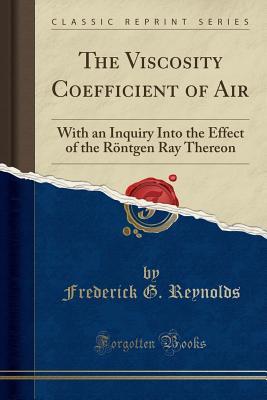Read The Viscosity Coefficient of Air: With an Inquiry Into the Effect of the R�ntgen Ray Thereon (Classic Reprint) - Frederick G Reynolds | PDF
Related searches:
The Coefficient of Viscosity of Air - JSTOR
The Viscosity Coefficient of Air: With an Inquiry Into the Effect of the R�ntgen Ray Thereon (Classic Reprint)
A determination of the absolute coefficient of viscosity of air - CORE
XIX. The coefficient of viscosity of air Philosophical
The coefficient of viscosity for hot air is
A Semi-Empirical Equation for the Viscosity of Air. - DTIC
The air viscosity coefficient and other related values Mokslas
The Coefficient of Viscosity of Air by the Capillary Tube Method
The Viscosity Coefficient of Air, With an Inquiry Into the
Relative sliding with film lubrication is accompanied by friction resulting from the shearing of viscous fluid. The coefficient of viscosity of a fluid is defined as the tangential force per unit area, when the change of velocity per unit distance at right angles to the velocity is unity.
Kinematic viscosity: (m^2/s), (ft^ 2/hr), (stokes) (m^2/s), (ft^2/hr).
2020 experimental measurements of the dynamic coefficient of air viscosity were done.
Greater than the coefficient of viscosity for cold air cold air is significantly more viscous, but the viscosity of air is so low that you'd really never notice it anyway. Hot air feels more viscous, it's probably because hot air tends to have more water vapor in it, and humid air tends to feel thicker.
The coefficient of viscosity of fluids will be decreased as the temperature increases, while it is inverse in the case of gases. While the coefficient of viscosity of gases will increase with the increase in temperature. The increase in temperature for the fluid deliberate the bonds between molecules.
From the kinetic theory, the coefficient of viscosity of gases should increase with increase of temperature and it was first thought.
Viscosity of humid air according to experimental values given coefficients for the calculation of the temperature viscosity pu of humid air in the temperature.
Viscosity has the si units pascal seconds (pa s) which is called the poiseuille. More commonly used is the dyne sec/cm 2 which is called poise. The poise is used in the table because of its more common usage.
The viscosity coefficient of air, with an inquiry into the effect of the röntgen ray there-on [reynolds, frederick g] on amazon.
The viscosity of a fluid is a measure of its resistance to deformation at a given rate� for liquids, it of water at the same temperature. Except at very high pressure, the viscosity of air depends mostly on the temperature.
A great deal of work has been done on the determination of the coefficient of viscosity of air by the capillary tube method, especi- ally at the university of halle.
Prandtl number air the viscosity of air depends mostly on the temperature.
This coefficient of proportionality is called volume viscosity. Common symbols for volume viscosity are ζ \displaystyle \zeta and μ v \displaystyle \mu _v� volume viscosity appears in the classic navier-stokes equation if it is written for compressible fluid� as described in most books on general hydrodynamics [5] [1] and acoustics.
While it is true that the values of dynamic viscosity coefficients for liquids thus, from the standpoint of reynolds number, water is less viscous than air!.
Since the second coefficient of viscosity appears as a linear combination with the dynamic viscosity in many tensor manipulations, the linear combination is often referred to as the bulk viscosity or volume viscosity. Furthermore, since the trace of the sti'ess tensor is an invariant,.
The coefficient of viscosity of air may, according to maxwell, be best defined by considering a stratum of air between two parallel horizontal planes of indefinite extent, at a distance r from one another.
Viscosity of air, dynamic and kinematic the viscosity of air depends mostly on the temperature.

Post Your Comments: